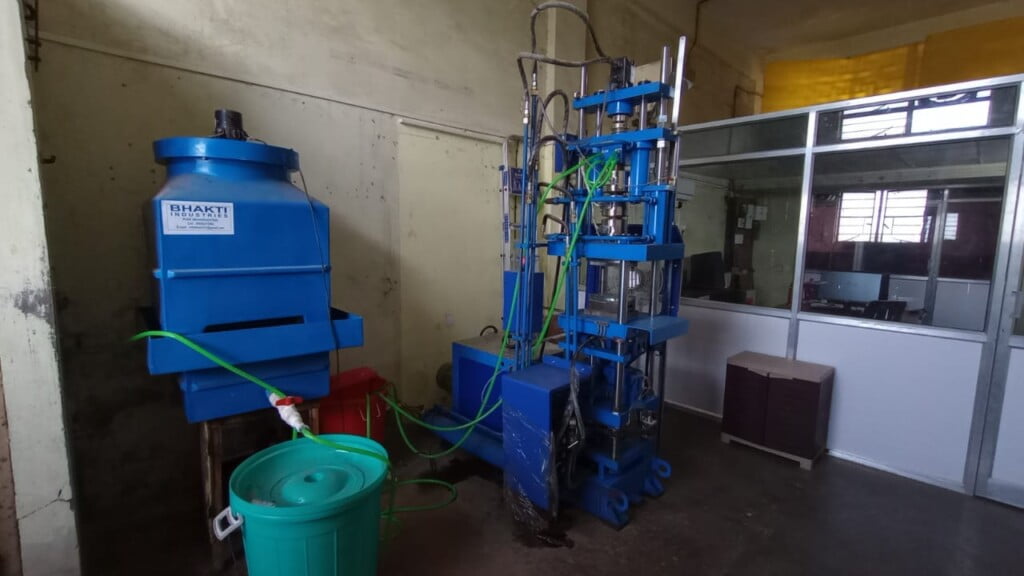Dear Friend of Ashaya,
The last letter I sent to you was perhaps a bit morbid. This one is not.
The countless hours of work we have put in over the past year are finally bearing fruit (and patents), and we are liking the taste of it – at least so far.
It’s hard to recycle post-consumer metallized multi-layered plastic packaging (MLP – yes, you’re right, in this case, an acronym is worthy).
Like really hard. We know because that’s what we have been trying to do.
MLP consists of 3-5 different types of materials including plastics (of multiple types), aluminium and paper all fused together by adhesives or hardcore heat, to create this useful packet that can store your favourite chips and keep them fresh for ages.
But the sheer multiplicity of the material makes it a pain in the butt to recycle. And because we are dealing in post-consumer waste, it sometimes contains tobacco, tissue, spit, salt, hair, masala and all the other good stuff shoved into it.
That’s why globally, near 0% of flexible plastic packaging is recycled. Yea, the number rounds down to zero. It’s the worst.
The little bit of it that is recycled is end-of-life recycling. Which essentially means that it gets used one more time, and poof, that’s it. It gets either burnt for energy, burnt for fuel, or compressed into bricks and furniture.
Don’t get me wrong, these are all decent solutions – better than MLP ending up in landfills. But they do result in either destruction of value or in a delay of the inevitable.
What we are doing is different.
We are extracting materials out of the MLP and unleashing them into the economy so they can be used over and over again.
In the last month or so, we finally got to a point that got us a little giddy.
The material properties that result from our recycling of MLP are comparable to virgin plastic, better than most recycled mono-materials and much better than alternative MLP-based recycled granules. In other words, it’s pretty damn good.
To be fair, that’s what we were aiming for, but we were hoping to do that with only 50% of MLP waste in our formula. This material is so crap that we thought that if we pull it off with only 50%, that would be great.
But we are pulling it off with 90% recycled MLP content.
This is not some green-washed “90% recycled”, it’s a true 90% – which means it takes into consideration all the additives and compatibilizers and polymers we are putting in.
And that’s important because what you don’t often hear about recycled materials and products is how much of it is actually recycled content.
Even if some folks do say “95% recycled”, do they mean 95% of the polymer or all added things? Including additives, what does the recycled % drop to?
See, I get this. Being fully transparent doesn’t really help. In fact, it makes consumers squirm and question and raise eyebrows.
But for us, and in general, transparency is key. And we want to champion that as much as we can.
Before we get too carried away though, I want to clarify that we don’t have the perfect solution yet. Some of our upcycled materials consist of two polymers (PP & PE) which is not great for recycling (but better than the original 5 different materials). Mono-material is the holy grail, and we’ll strive to get there.
But we don’t want perfect to be the enemy of good and better.
In other news, our lawyer messaged us earlier this month and gave our goodness a little more validation. He said that our MLP recycling process has a 95% chance of getting patented domestically. And that the patent has been filed and we have a patent application number, which means that we officially have “patent pending” status woohoo!
So yes, there has been a lot of progress, but also yes, we still have a way to go.
And yes, you guessed right, there’s also a catch to all this goodness: our recycling process is expensive.
Selling only the material would be like trying to make a sinking ship stay afloat. And it would have to be a different game – a centralized game focused on large, centralized factories, that involve transporting MLP to centralized locations. There’s nothing wrong with that game, just that it doesn’t marry with our utopia.
The only way for us to make our MLP recycling process economically viable is by producing and selling final products.
We are currently building out a rapid, mini-manufacturing process that uses 3D-printing and injection moulding to produce funky final consumer products. We already have the printers and moulding machines and have just onboarded a kick-ass design engineer.
So hopefully, in the next letter I write to you, I’ll be able to tell you about our first product. Right now, we don’t know for sure. Yes, we do have some idea of what it could be, but we are not sure if we can actually execute on it.
Like change, uncertainty is also a constant.
All that evaporates a little to the hard truth that there’s still a war being fought in the Northeast. And that countries in the global South are facing bankruptcy and food shortages while a recession looms.
But the hustle continues. What else would we do?
Ahh, that was a long letter. I can imagine my sister going, shorter Anish, shorter. Thank you for making it to the end though.
Warmly,
Anish

The 90% MLP Recycled Material! Yes, you can’t really make out what the big deal is, but man, this was tough.

Our mini-manufacturing unit taking shape. The Bhakti Industries Cooling Tower guys got their branding right huh?
